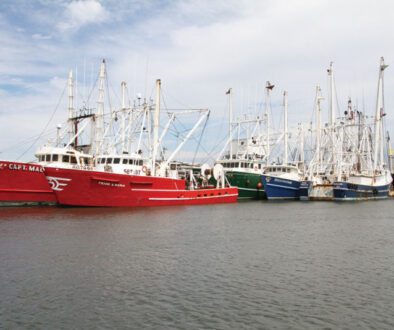Beneath the Emerald Current

“Memories have huge staying power, but like dreams, they thrive in the dark, surviving for decades in the deep waters of our minds like shipwrecks on the sea bed.”
—J.G. Ballard
Brian Sullivan pulls something from his pocket, unwrapping the cloth that surrounds it with a reverence usually reserved for fragile, dainty things, not the flat piece of brass he holds in his hand. With a slot just wide enough to accommodate a thin strap, the object’s tarnished surface is inscribed with “Champion” and “195.”
“This luggage tag represents 10 years of my life,” posits the diver and lifelong Cape May resident. For a decade, Sullivan had been combing the remnants of a shipwreck he believed to be the Champion, the doomed paddlewheel steamer that sank to the bottom of the sea off the coast of Cape May after colliding with a passenger ship on November 7, 1879. Sullivan was looking for a definitive piece of evidence—anything—that would allow him to positively identify the wreck, known as the “inshore paddlewheeler” and by extension, also confirm the identity of the very similar “offshore paddlewheeler,” the Admiral Dupont, resting nearby.
Finally, in June of 2010, Sullivan and his diving partner Rusty Cassway deployed their hydraulic dredge, a device they had built to clear large amounts of sand from whatever lies on the ocean floor. It worked, blowing the sand off the tiny brass shred of history, and in that moment, validating the suspicion that had consumed Sullivan for so many years.
“Brian is a bit obsessed with the Champion,” Cassway says. He and Sullivan have owned and operated the Cape May wreck diving charter boat Research Vessel Explorer for the last 13 years, and one may argue that Sullivan isn’t the only one in the room who is obsessed. Cassway collects portholes from his dives, and they’re hanging all over the walls and ceiling of his downstairs family room, along with myriad other artifacts retrieved from expeditions. Certified since 1981, Cassway caught the diving bug after watching Sea Hunt on television. His first big Cape May dive was Moonstone, a World War II patrol boat that sank after a collision with another ship in the dark of night when it was running without lights, a common practice at the time to avoid enemy detection.
Cape May and the surrounding area inspire that obsession in the hearts of divers from all over the world, and with good reason. “More than 5,000 shipwrecks dot the shore of New Jersey and New York, including 250 World War I and World War II vessels, tankers, freighters, and passenger liners,” says Gene Peterson, owner of Atlantic Divers, a dive shop in Egg Harbor Township. “We’ve got ships from the Revolutionary War, the Civil War, and the War of 1812.” And it is the access to the wrecks that makes this particular area so irresistible to divers. “Other areas of the world, such as the Mediterranean, have more restrictions on wrecks than we do here,” he adds.
Peterson’s experience is as vast as the oceans he dives. By age 19, he was the youngest certified dive instructor in the country, and he’s been leading wreck diving charters here and elsewhere since 1970.
So what’s it like?
Under the Water
“Most people who come here look at the ocean and imagine a shipwreck like a Disney movie, with the captain draped over the helm in a pirate hat. And it’s not like that all,” says Peterson. “When you get 20 to 30 miles offshore, it’s not uncommon to have 40 to 70, even up to 100 feet of visibility. And there’s nothing like landing on a gigantic freighter and seeing 100 feet all around you.”
Dan Lieb, president of the New Jersey Historical Divers Association, waxes poetic about his experience diving the waters off New Jersey’s coast. “In the tropics, people dive in an azure world. But here in the northeast, we dive in an emerald world. Everything is green.” In the shallower water, visibility generally ranges from 15 to 25 feet, according to Lieb, meaning that large underwater objects cannot be seen in their entirety. For Lieb, however, this heightens the sense of mystery and adventure. “Here, if there’s a shadow in the distance, you might nudge your buddy and point it out, to say ‘let’s go over there.’ There’s more of an explorer’s nature when you dive in this area.”
“For a pile of ‘junk,’ a shipwreck can be very attractive, especially when the diver is experienced,” he continues. “Columns may have fallen apart, but you can put them back together in your mind and imagine how they would have looked.”
Mentally reassembling those fragments into some semblance of the ship’s original appearance often requires a bit of imagination. Some of the wrecks are upside down, including the India Arrow and the Northern Pacific. There is the skeleton-like shell of the brand new S-5 submarine, sunk on her maiden test voyage on September 1, 1920, when a broken valve filled her with water. And many of the wrecks have been crushed by the weight of the water, leaving their filleted remnants splayed flat on the ocean floor.
Diving isn’t for the faint of heart, regardless of safety advances in the sport. Over the years, divers have experimented with mixtures of different kinds of gases. “In the 1980s, we did all our dives on regular air,” Cassway recalls. “At depths greater than 100 feet, the nitrogen in the air would act like laughing gas, causing a condition called nitrogen narcosis. It was like having a few beers, and it would tunnel your vision. Today, we add helium to the mix and you feel normal. Then, on the way up, we breathe close to pure oxygen.” The changes allow him to dive as deep as 250 feet.
It’s more than just the diving, though. “Financially, buying a boat might be a bad investment, but in terms of lifestyle and friends, it’s the best investment we could’ve made,” he maintains. “Spending the day on the water with friends is as much fun as the diving. It can take five and a half hours to get to the wreck. It’s 20 minutes down, and then an hour to come back up. You leave at 4am, get home at 10pm, and you might only have spent 40 minutes at the bottom. But you got to drop into a time capsule which no one’s touched.”
For Sullivan and Cassway, diving has become a family affair as their children have grown old enough to dive with them. Cassway’s daughter Sarah, now 18, earned her diving certification at age 11 after being surrounded by the pursuit her whole life. Two summers ago, she completed her first “real” dive (to the Champion, of course) and brought back another luggage tag, a couple of forks, and even a porthole of her own.
Diving into History
In Gene Peterson’s eyes, there is more history in the water than there is on land. “When you find a shipwreck, you can see, touch, and taste history,” he says. “In a museum, everything is behind glass, but when you go out and discover a new wreck, you’re the first one on it. If it’s a war ship, you see all the guns and bullets spewed across the deck. You see the guns aimed toward the water because it was in a battle.”
Some of the shipwrecks encompass a truly massive scale, like the Varanger, located about 28 miles off the coast. At almost 500 feet long, it broke into three sections when two torpedoes slammed into it during World War II. Today, its remains are scattered across 1000 feet. “It’s like an underwater city,” describes Peterson. “You can dive it 100 times and never be in the same spot.”
Peterson also notes that every time a diver aims for a particular wreck, he or she might find something else. For years, divers have searched for the wreck of the Cayru, a freighter lost when it was torpedoed in 1942. But looking for it led to other discoveries, such as the S-5 submarine and the Brian C tugboat.
For divers and non-divers alike, Dan Lieb suggests visiting the many maritime museums in the state, which generally include shipwreck history. “Any of the lighthouses will have their own maritime history, too,” he adds, “where visitors will find photography and video that give you a good idea of what it’s like to dive off New Jersey’s coast.”
Bringing Closure
Identifying wrecks holds significance for more than just history buffs. “In World War II, news reports were deliberately vague, for security reasons,” Peterson relates. “There was little information about where ships were heading, or where they went down. News articles would simply say ‘lost without a trace,’ so these mothers, sons, and daughters didn’t know what happened to their brother or father. Some of them died without that knowledge.” By locating the final resting place of a loved one’s vessel, surviving family members from lost ships may finally find closure.
The Miraflores offers one such instance. On February 19, 1942, two torpedoes from a German U-boat sent the Miraflores to the bottom of the sea somewhere off Cape May’s coast, with her exact whereabouts unknown. The mystery was solved in 2007, however, when Peterson realized that the brass helm of an unidentified ship he had dived was manufactured by a company in Glasgow, Scotland. By then combing through Glasgow University archives, he was able to positively identify the ship as the Miraflores.
It was a powerful moment. “We posted on warsailors.com [a forum where users can post messages about lost ships for which they are searching] and got a couple of responses saying ‘my grandfather was a crew member.’ All these different families were united, with no clue what had happened to the ship,” Peterson muses. “They were finally able to find some type of peace from that discovery.”
Another example is the Jacob Jones destroyer. Torpedoed in World War II, only 11 members of the original 130+ crew survived. Many of those who initially escaped to the lifeboats or open water subsequently died when the ship’s depth charges went off as she slipped beneath the water. One of those survivors was Joseph Tidwell, a retired U.S. Navy Master Chief. In 2011, Peterson and the RV Explorer crew took Joseph Tidwell’s grandson out to dive the wreck. Eric Tidwell, who followed in his grandfather’s footsteps by also joining the Navy, reflected on the dive in an interview with the Press of Atlantic City on July 22, 2011. “It just solidified the whole story in my mind and the tremendous destruction,” he says in the article. “Now there’s coral and fish everywhere. I think it’s a suitable memorial.”
The Ticking Clock
Even submerged in their quiet tombs, shipwrecks still impart a sense of urgency to those who seek them out. Gene Peterson has been diving these waters since the early 1970s, and some of the wrecks he was diving when he was a kid aren’t around anymore. “Storms, sands, and Mother Nature have torn them to pieces until they cease to exist,” he says, which makes their discovery all the more important. “Finding and rescuing artifacts is a way to preserve them.”
Documenting the expeditions offers another method of preservation. Rusty Cassway shoots high quality photos and video with his Canon 6D sealed in an underwater housing system. “I can sit here and tell you all about it,” he says, “but in the end you don’t really know what it’s like. Our final dive of the year last year was the Northern Pacific, and that whole dive is documented. We’ve gone down on 250 foot wrecks with our scooters and our camera and done it all.”
Preserving that legacy has spurred Peterson to create displays for museums, including Philadelphia’s Franklin Institute. He currently has four on exhibit at the Maritime Museum of New Jersey in Beach Haven, and one about shipwrecks for the Museum of Cape May County, which will run through early October. That one includes, among other artifacts, Brian Sullivan’s prized #195 luggage tag from the Champion.
“These shipwrecks are dissolving into the sea,” Peterson reflects. “I’m a lucky part of a generation that got to see them when they still intact and in high relief. A lot of them are collapsing and crumbling, and within the next 20 to 30 years, they’ll be gone…just a rust stain the sand.”



